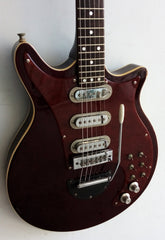1979 Greco BM900
Share
This one caused quite a stir when I posted pics on social media the other day so as promised, here's a blog with heaps of pics for you all.

The story of Greco is (reasonably) well known both around here and online in general. It's no secret I love vintage (and modern) Japanese guitars and Greco have been one of the best for many years. The story of the Red Special, Brian May's home made guitar is well known and available elsewhere so I won't bore you with that either. We'll just look at this BM900, the first commercially available copy of this iconic guitar worldwide.
The story of Greco goes back to 1960, when Kanda Shokai introduced the Greco brand to make acoustic guitars made by Matsumoku for the domestic market and then started using Fujigen from about 1974. This is the factory that made this wonderful Red Special copy.
The idea of these Red Special copies dates all the way back to 1972 when Mr Shokai asked Mr. Hidesato Shiino to come over from Yamaha and work for Greco on designs and ideas. He had been a consultant on many big Japanese guitar brands and was primed to get a new thing happening at Greco.
The Gibson importer in Japan had asked Greco to make some Gibson copies in the mid 70's to export to the US as Ibanez and some of these guitars also ended up with Greco on the headstock with the "Super real" series being especially nice copies made by Fujigen.


Guitarist, Mick Ralphs of Bad Company visited Greco in the early 70's and talked to them about "custom guitar manufacturing" where they allegedly offered him a copy of Brian May's Red Special.
By '81 Greco were in talks with Fender and would, within a year become Fender Japan making the SE Strat series by Fujigen with a Fender licensed name on the headstock. But that's another story.
Back in the early 70's a famous guitarist named Shigeru Mairi had approached Greco with a similar idea to Mick, and wanted a MUCH better copy of a Les Paul than the EG-360 they were currently making. This idea caught on and Greco started selling more of these custom order guitars to professional guitarists in Japan, and overseas.


It got to a point where Greco decided to start a ... custom shop of sorts with a line called OMS (Order Made System) especially for these top end guitars, and demand was huge both domestically and to "in the know" players overseas.
Greco decided they needed a "production" version of the OMS line, which were very expensive and still essentially one-offs and the Project Series was born, essentially using the same designs and ideas but manufacturing in batches of about 40 guitars at a time.

The Greco RW ('74), GO ('75) and M ('77) series were part of this program and all three designs did well in Japan. The M series would go on to be known as the Ibanez Iceman to most of us overseas.
The first BM900's were made as Project Series guitars around 1976 after another famous Japanese guitarists ordered one through the OMS series and started playing it to much interest. The Project Series sat in the line between the standard production model and the OMS series and throughout the seventies all of these BM's were made by Fujigen as part of the Project Series which ended in 1980.


In the early eighties after demand for the BM, Greco started production of a standard series version in 1983 called the BM-80 which turned into the (same guitar) BM-90 in 1987, and there are a few small changes to the guitar in general. The back plate is bigger and the truss rod cover is different on the eighties standard series. I've owned three of these BM's in both Fujigen made PS series and one eighties standard series, and to be honest, from memory I can't remember much difference, but these seventies Project Series versions are considered better made, and more collectable, both OS and in Japan.
So, what's it like?

It's an amazing guitar indeed. I must admit to not being a huge Queen or Brian May fan. I like some of their stuff and I do really like some of his playing and his tone is spectacular, but they're not really my thing all up. Having said that, there is really something about the "Red Special" that is VERY, VERY cool. It's a great looking guitar for reasons I can't really put my finger on. It's one of the most aesthetically pleasing shapes for a double cutaway there is. The double bound body really sets the shape off nicely too. It's actually a very nice, and complimentary headstock shape too. Brian (and his Dad) had a great eye for design and detail.
The Greco version differs from Brian's original in a few ways but to think that they started making these around the time Queen were just taking off globally shows the sort of forward thinking strategies these Japanese companies had. They would have had to work from pictures in magazines and photos from album promos. There was no internet to just type "Brian May Red Special" and you couldn't buy one to copy. It would take years for other manufacturers to start making copies of these, some, unlike these, with Brian's blessing.


Brian's original was of course a series of laminated timbers (oak, block board and mahogany veneer) for an essentially chambered body and the neck was "set" (with screws) oak with painted oak fretboard, all the way back to the bridge pickup. The Greco version is a solid mahogany body with a standard set mahogany neck with rosewood fretboard. Construction like the original, especially with similar timbers would have been prohibitively expensive and these were meant to "look like" the original, not play like it. Another (thankfully) difference is apparently the neck of the original is HUGE while this has a VERY nice, thin but comfortable neck profile.


The Greco keeps with the 24 fret neck with access all the way to to dusty end although it is 24.75" scale, not 24" like the original. It's an amazing guitar to play. The original Special also has a zero fret which the Greco didn't carry over, which is a shame.

The headstock on the original is slightly smaller and thinner which means the strings pass (almost) straight to the tuners from the string guide but the Greco has a slightly wider headstock with the strings taking a slight angle from the nut. The headstcok angle is also greater than the original which had a VERY shallow angle. The tuners are Greco branded Grover copies.

The pickups in the original are Burns pickups that Brian rewound the centre one to give him humbucking in some positions. These Greco pickups (unique to this model PU-90 (PUC-BM9)) are standard Strat (in series) style pickups with alnico magnets whereas the original Burns had ceramics. The differences in electronics doesn't stop there either. The mini switches for pickup ON/OFF and phase switching are slider switches on the original but mini toggles here. I actually like the look of the mini toggles, and, well, they do the same thing sonicly. The knobs are unique to this Greco too being copies of Brian's originals although reversed so the Vol is forward and Tone back. Early versions were available with a black scratchplate but soon went to this great tort which also looks great.


The bridge is a Gibson Harmonica bridge with different posts and does a close enough visual approximation of the custom unit Brian originally made for the Special, although not with the handmade roller saddles of the original. The vibrato is based on a Mustang unit (again, unique to this model Greco) with a half circle plate to replicate the spring cover plate on the original. The Greco works on a similar idea (pulling the springs instead of pushing) with a small spring cover on the back. Brian used motorbike valve springs on his original with adjustment through holes near the rear strap button.


While I haven't owned (only set up and played) several of the more common "reissues and copies" available now I personally think these are my favourite. They play and sound like a REALLY nice, well made guitar while looking like that amazing Red Special. To me the Strat vibrato on some reissues ruins the beautiful lines of this guitar too.

This one is in great condition with some marks and player wear but it's by far the best example I've owned AND has it's original hardcase (with keys and tools), which is a plus in the collector world. I REALLY like the deep red finish with the mahogany grain peeking through on this one too. The old me would have kept this guitar but the new me wants it to go and get played so it will be in the shop this weekend.

